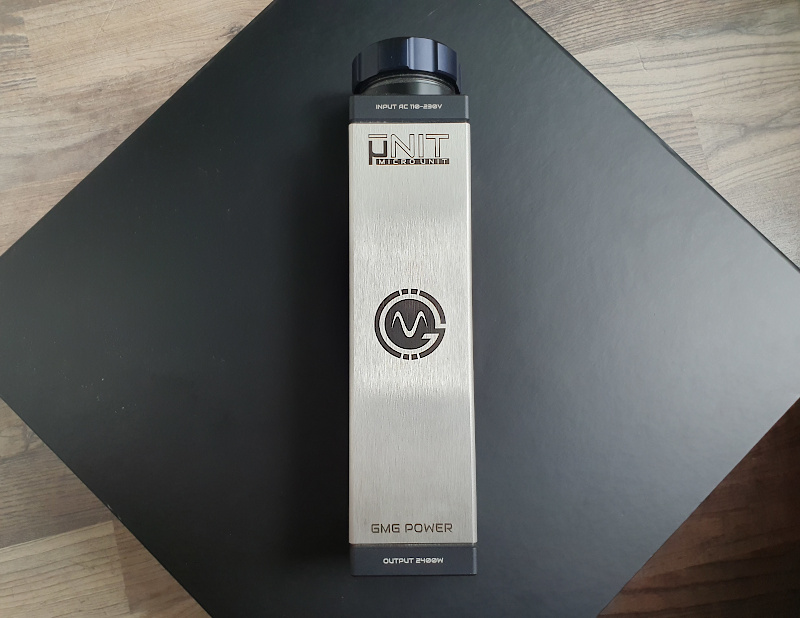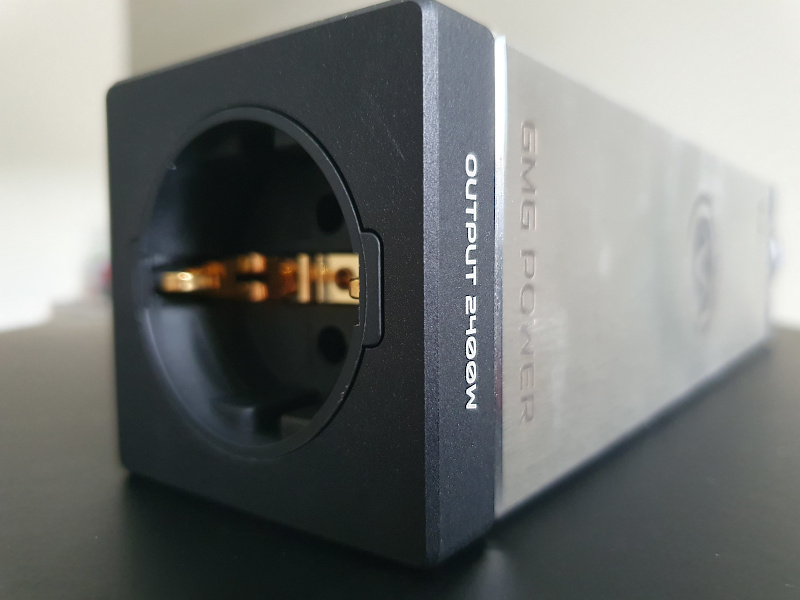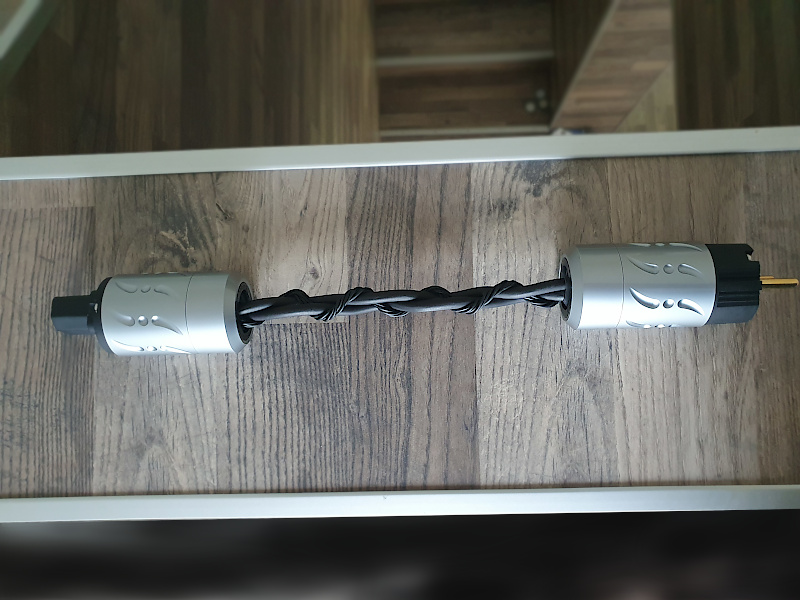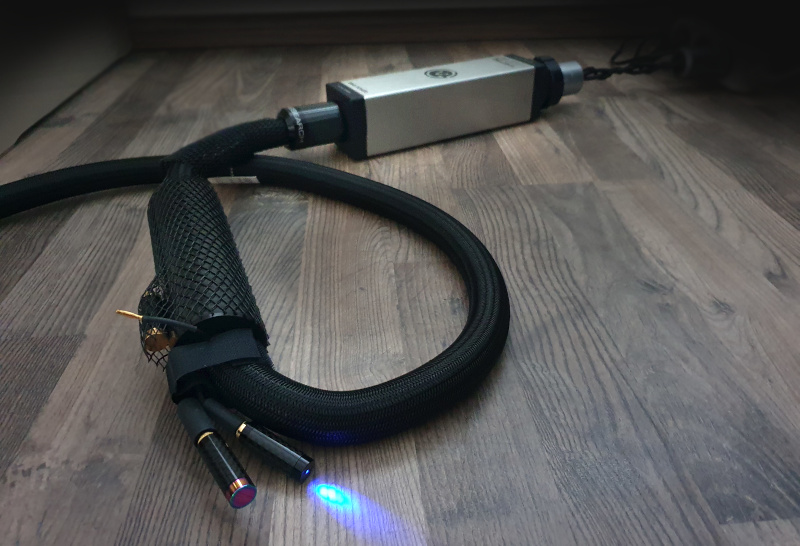GMG POWER microUNIT
Power conditioners
The GMG Power’s theory says that harmonic noise is responsible for most of the noise in the power grid. The interference is generated by factories, traffic and telecommunication installations, and, of course, commercial and domestic wifi networks. The dirty power on the input cannot provide clean sound on the output, logically. Even sophisticated power filters do not always work as expected and audiophiles complain that although they clean the sound, they are a bottleneck for juice from the socket and impair dynamics and rob music of its power. There are just a few that can make filtration work without undesirable side effects – and GMG Power is one of them.
Function and form
The microUNIT is the latest addition to the GMG Power’s family. The latest and the smallest. This filter cub is a downscaled version of much bigger and more capable X-Blocker. That said, it is very dense in the best that GMG can offer, but the output is limited to a single outlet of 16A/3200W continuous, 40 000A/10 0002W peak power respectively. The 260mm long stainless steel case is 60mm x 60mm, and it has a Schuko outlet on one end and IEC outlet on the other. Both are gold-plated Furutechs, the IEC side is equipped with a lockable collar from Oudesign. This smart solution reliefs the strain on the connector and fasts it like it is welded in. The specs say that the GMG Power microUNIT working range is 5kHz to 1GHz where the filter suppresses HF/RFI noise by 15-95dB. The unit is made with care and the usual high workmanship standard from GMG.
Bass management
To benefit from the microUNIT, it must be used in the right position. When I inserted it in front of the whole audio set-up (between the wall socket and the first power cable that led to the power filter) I heard negligible change to sound. I could detect a tad more precise imaging and better contours of the instruments; however, this was not the change that would make me reach for a credit card and give a call to GMG. I could not use the microUNIT on the entrance to the main filter (Shunyata Denali) for it uses IEC C19 and I did not have a spare C19 plug.
But I had a spare C15 gold-plated Viborg plug and a Viborg gold-plated Schuko plug, so I decided to build a very short power interconnect. The microUNIT is an inline filter, so to use it you will need another power cable. Not only is this expensive but it also adds another length of a cable and you know how bulky power cables are these days. A very short interconnecting cable was a good solution. I used two thick 6N OFC copper in cotton wires for phase/null and a braided silver-plated AAI strand for ground. Altogether a 0.30m lossless power cable. If you are interested, let me know, the cable remained unused after the test.
Clarity & delicacy
Further experiments were done with microUNIT at the end of the power cable, either the one that enters the amplifier, or the one to the source component. It makes more sense to use the microUNIT as the last thing before the power enters the component. The input power from the wall is "dirty" (Read: a dedicated power cable from the domestic switch box and then Synergistic Research Atmosphere Level 2 power cable ending in the Denali). The primary filter (Denali) removes most of the interference and then sends it to the electronics reasonably ‘cleaned’. Then the power travels through a well shielded path (Ansuz C2), but - no illusions – some noise will be picked up again anyway, if not from the air then from the connected electronics. The addition of GMG microUNIT creates a filtration cascade just 20cm upstream of the component inlet. From the amplifier's point of view, the microUNIT is the first thing the amplifier se es in the power path, and this thing provides clean (or much cleaner) power. At least that's how I rationalize it to myself.
Be that as it may, in these positions microUNIT has opened up the sound more significantly. Virtually everything was more concrete and solid, better cut out of the blacker background, each sound better delineated. The unit's contribution was very audible on my favourite a capella traditional Down to the River to Pray (Alison Krauss), that was made famous by O Brother, Where Art Thou? movie. The track features some pretty challenging sibilants and pops, both from Alison and the ten-headed Baptist choir that joins her. On lesser set-ups, the male and female voices are usually presented as a clump that gets clearer and better defined as the playback chain grows more capable. The GMG unit handled all the challenging s’s, sh’s and f’s with great competence, and it precisely conveyed all the p's and b's that popped out of the speakers with greater ease and fluidity. The magic of making each syllable legible and shaping the consonants, launched through the lips of virtually any performer, was repeated album after album, track after track.
Tonal accuracy
The microUNIT (in the right configuration) improves the transient attacks. It is not sharpening them in terms of tonality, it is tightening them, like from rounded to more precisely defined peaks. Steve Khan’s Borrowed Time is an ethnical jazz album that feels like improvisation and features some interesting instruments. Like guiro, a primitive open-ended wooden cylinder played by a wooden stick that is dragged across the cylinder’s notches to produce scraping sound. With the microUNIT in place, it was as if an old and worn-out guirro was replaced by a new one, the sound of the wood on wood was more there, its clarity within the mix improved. The acoustic guitar, piano, percussions, harp, chimes, and other transient sensitive instruments were also improved. By tightening up these attacks they cease to mask other musical events, so the music feels more open and better organized.
The microUNIT had almost no effect when it interconnected AAI Maestoso power cable (on the output from Stromtank) and Accuphase SACD player. Perhaps it makes sense as the clean power is delivered by Stromtank’s batteries, not by the grid. So, I bypassed the Stromtank with an extra length of cable (Synergistic Research SRX) and the combo of the SRX + the microUNIT proved to be a very dynamic and complete combination. It was interesting to hear how all the active tech in the SRX was stepped up by adding a HF filter at its end, or at its beginning as seen by the connected piece of electronics. The GMG Power microUNIT was never hit and miss; although its contribution varied in intensity, it was very consistent in how it worked.
Spatial resolution
For GMG gear owners: I don’t think it would be out of place to daisy-chain the microUNIT with any existing GMG filtering unit. In fact, one of the best synergies I heard was when the microUNIT was placed on the extension cord from the GMG’s X-Blocker. Adding the microUNIT to a high-quality power distributor – think Nordost and Ansuz – could be another great option how to add noise-suppressing function to a distribution unit that has no or very basic filtering. The MircoUnit is very flexible in use and its effectiveness seems to be additive.
In GMG, they have turned a good idea into a smart solution that has all the positives and no negatives in terms of sound. I would like to see improvements in the unit’s ergonomics, though. If your audio components are arranged horizontally on the floor or on platforms, then you won't run into a problem and the microUNIT will be supported the same way the components are. But if you use a vertical arrangement in a rack or a cabinet, you'll have to figure out how to hang the relatively heavy unit (1.80 kg) from the back of the component so that the microUNIT doesn't pull it down from the shelf nor does it break the IEC connector out of the component´s chassis. You can get around this with a long enough power cable between the microUNIT and the component, but as mentioned above, it kind of defeats the purpose and will cost extra money. It might be worth replacing the rectangular stainless-steel tube with something lighter (aluminum, carbon) as it is responsible for a large part of the microUNIT's weight.
Note: The microUNIT's function is very specific as it only filters the HF noise, so it is not a full-fledged power conditioner, distributor or a regenerator. Therefore individual parameters are not evaluated and ranked. Theoretically, it can also be seen as a power cable extension with built-in filters.
Recommended resellers
GMG Power, Nedakonice, tel. +420 739 626 436
Manufacturer's website: http://www.gmgpower.cz/
Associated components
- Sources: Accuphase DP-720, Ayon CD-35 HF Edition
- Amplifiers: TAD M-2500, Audia Flight Strumento No.8
- Interconnects and speaker cables: AudioQuest Dragon Bass | Zero, Krautwire Numeric Digital, Ansuz Signalz C2, Synergistic Research SRX
- Loudspeakers: TAD Evolution One E1, Sonus Faber Gravis I, Silent Laboratories Equilibrium
- Power conditioning: Stage III Concepts Kraken, Synergistic Research Atmosphere Level 2, Synergistic Research SRX, AAI Maestoso, AAI Assoluto, Silent Laboratories S.W. I, II & III, Shunyata Research Denali 6000T, Synergistic Research Galileo SX Ground Block, RD Acoustics EMI Neutralizer, GMG Power X-Blocker, Stromtank S-1000, Nordost QPoint, Qv2, QWave, QSine
ACCUPHASE PS-510
The simple fact it actively compensates for the AC power fluctuations does not mean that the device generates absolutely clean power – just try and change the power cord that comes with the PS-510 to some other and you will experience ...
Recommended resellers
Nisel SK, Bratislava, tel. +421 905 203 078
ANSUZ MAINZ8 D2 + MAINZ D2
The Ansuz Mainz8 D2 is not a filtration device. It does not have any voltage regulation or oversized transformers inside, rather it relies on several smart technologies that should distribute the voltage, as pure as possible, to your ...
Recommended resellers
RP Audio, Ostrava, +420 737 366 831
ANSUZ Sparkz TC2
With three Sparkz TC2 units plugged into the power conditioner the blacks became nano-blacks as if all electric noise that existed within the system had vanished and this exposed the recorded sounds. The downside of it was that the ...
Recommended resellers
RP Audio, Ostrava, +420 737 366 831
BLOCK AUDIO Dogblock
The philosophy of the Dogblock is simple: the power distributor gets inspired by the good designs that already exist on the market, improves on them technically and adds amazingly precise craftsmanship. Everything is effective and ...
Recommended resellers
Audiostudio s.r.o., Olomouc, tel. +420 608 752 475
FURUTECH Daytona 303E
The Daytona inherits its name from a Daytona GT racing car so you can expect a lot of horsepower under its hood. And it is, indeed. The internal circuitry of the unit provides a user with generous surge protection and advanced ...
Recommended resellers
Audiostudio s.r.o., Olomouc, tel. +420 608 752 475
GIGAWATT PC-4 EVO
The GigaWatt’s PC-4 EVO represents the state-of-the art of power conditioners. It is more effective than any other filtering device that I have come across since I reviewed Accuphase’s PS-500 back in 1996 - that is in the last ...
GIGAWATT PF-2
The PF-2 represents the highest model passive power strip in GigaWatt´s portfolioas more sophisticated units are regular power conditioners. In my point of view Adam Szubert found nice balance between overall built and functionality ...










